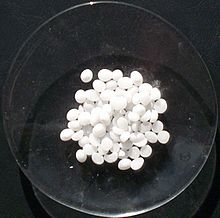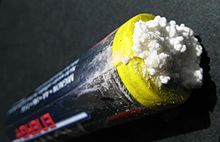Potassium hydroxide

| |

| |
| Names | |
|---|---|
| IUPAC name
Potassium hydroxide
| |
Other names
| |
| Identifiers | |
3D model (
JSmol ) |
|
| ChEBI | |
| ChemSpider | |
ECHA InfoCard
|
100.013.802 |
| EC Number |
|
| E number | E525 (acidity regulators, ...) |
PubChem CID
|
|
RTECS number
|
|
| UNII | |
| UN number | 1813 |
CompTox Dashboard (EPA)
|
|
| |
| |
| Properties | |
| KOH | |
| Molar mass | 56.11 g mol−1 |
| Appearance | white solid, deliquescent
|
| Odor | odorless |
| Density | 2.044 g/cm3 (20 °C)[1] 2.12 g/cm3 (25 °C)[2] |
| Melting point | 410[3][4] °C (770 °F; 683 K) |
| Boiling point | 1,327 °C (2,421 °F; 1,600 K) |
| 85 g/100 mL (-23.2 °C) 97 g/100 mL (0 °C) 121 g/100 mL (25 °C) 138.3 g/100 mL (50 °C) 162.9 g/100 mL (100 °C)[1][5] | |
| Solubility | soluble in alcohol, glycerol insoluble in ether, liquid ammonia |
| Solubility in methanol | 55 g/100 g (28 °C)[2] |
isopropanol
|
~14 g / 100 g (28 °C) |
| Acidity (pKa) | 14.7[6] |
| −22.0·10−6 cm3/mol | |
Refractive index (nD)
|
1.409 (20 °C) |
| Thermochemistry | |
Heat capacity (C)
|
65.87 J/mol·K[2] |
Std molar
entropy (S⦵298) |
79.32 J/mol·K[2][7] |
Std enthalpy of (ΔfH⦵298)formation |
-425.8 kJ/mol[2][7] |
Gibbs free energy (ΔfG⦵)
|
-380.2 kJ/mol[2] |
| Hazards | |
| GHS labelling: | |
  [8] [8]
| |
| Danger | |
| H290, H302, H314[8] | |
| P280, P305+P351+P338, P310[8] | |
| NFPA 704 (fire diamond) | |
| Flash point | nonflammable |
| Lethal dose or concentration (LD, LC): | |
LD50 (median dose)
|
273 mg/kg (oral, rat)[10] |
| NIOSH (US health exposure limits): | |
PEL (Permissible)
|
none[9] |
REL (Recommended)
|
C 2 mg/m3[9] |
IDLH (Immediate danger) |
N.D.[9] |
| Safety data sheet (SDS) | ICSC 0357 |
| Related compounds | |
Other anions
|
Potassium hydrosulfide Potassium amide |
Other cations
|
Lithium hydroxide Sodium hydroxide Rubidium hydroxide Caesium hydroxide |
Related compounds
|
Potassium oxide |
Except where otherwise noted, data are given for materials in their standard state (at 25 °C [77 °F], 100 kPa).
| |
Potassium hydroxide is an inorganic compound with the formula KOH, and is commonly called caustic potash.
Along with
Properties and structure
KOH exhibits high
Structure
At higher temperatures, solid KOH
Reactions
Solubility and desiccating properties
About 112 g of KOH
- KOH + CH3OH → CH3OK + H2O
Because of its high affinity for water, KOH serves as a
As a nucleophile in organic chemistry
KOH, like NaOH, serves as a source of OH−, a highly
- KOH + RCOOR' → RCOOK + R'OH
When R is a long chain, the product is called a
Molten KOH is used to displace
Reactions with inorganic compounds
Complementary to its reactivity toward acids, KOH attacks oxides. Thus, SiO2 is attacked by KOH to give soluble potassium silicates. KOH reacts with carbon dioxide to give potassium bicarbonate:
- KOH + CO2 → KHCO3
Manufacture
Historically, KOH was made by adding potassium carbonate to a strong solution of calcium hydroxide (slaked lime). The salt metathesis reaction results in precipitation of solid calcium carbonate, leaving potassium hydroxide in solution:
- Ca(OH)2 + K2CO3 → CaCO3 + 2 KOH
Filtering off the precipitated calcium carbonate and boiling down the solution gives potassium hydroxide ("calcinated or caustic potash"). This method of producing potassium hydroxide remained dominant until the late 19th century, when it was largely replaced by the current method of electrolysis of potassium chloride solutions.[11] The method is analogous to the manufacture of sodium hydroxide (see chloralkali process):
- 2 KCl + 2 H2O → 2 KOH + Cl2 + H2
Hydrogen gas forms as a byproduct on the cathode; concurrently, an anodic oxidation of the chloride ion takes place, forming chlorine gas as a byproduct. Separation of the anodic and cathodic spaces in the electrolysis cell is essential for this process.[17]
Uses
KOH and NaOH can be used interchangeably for a number of applications, although in industry, NaOH is preferred because of its lower cost.
Catalyst for hydrothermal gasification process
In industry, KOH is a good catalyst for hydrothermal gasification process. In this process, it is used to improve the yield of gas and amount of hydrogen in process. For example, production of coke (fuel) from coal often produces much coking wastewater. In order to degrade it, supercritical water is used to convert it to the syngas containing carbon monoxide, carbon dioxide, hydrogen and methane. Using pressure swing adsorption, we could separate various gases and then use power-to-gas technology to convert them to fuel.[18] On the other hand, the hydrothermal gasification process could degrade other waste such as sewage sludge and waste from food factories.
Precursor to other potassium compounds
Many potassium salts are prepared by neutralization reactions involving KOH. The potassium salts of carbonate, cyanide, permanganate, phosphate, and various silicates are prepared by treating either the oxides or the acids with KOH.[11] The high solubility of potassium phosphate is desirable in fertilizers.
Manufacture of soft soaps
The saponification of fats with KOH is used to prepare the corresponding "potassium soaps", which are softer than the more common sodium hydroxide-derived soaps. Because of their softness and greater solubility, potassium soaps require less water to liquefy, and can thus contain more cleaning agent than liquefied sodium soaps.[19]
As an electrolyte

Aqueous potassium hydroxide is employed as the electrolyte in alkaline batteries based on nickel-cadmium, nickel-hydrogen, and manganese dioxide-zinc. Potassium hydroxide is preferred over sodium hydroxide because its solutions are more conductive.[20] The nickel–metal hydride batteries in the Toyota Prius use a mixture of potassium hydroxide and sodium hydroxide.[21] Nickel–iron batteries also use potassium hydroxide electrolyte.
Food industry
In food products, potassium hydroxide acts as a food thickener, pH control agent and food stabilizer. The
system as E525.Niche applications
Like sodium hydroxide, potassium hydroxide attracts numerous specialized applications, virtually all of which rely on its properties as a strong chemical base with its consequent ability to degrade many materials. For example, in a process commonly referred to as "chemical cremation" or "
In chemical synthesis, the choice between the use of KOH and the use of NaOH is guided by the solubility or keeping quality of the resulting salt.
The corrosive properties of potassium hydroxide make it a useful ingredient in agents and preparations that clean and
KOH is also used for semiconductor chip fabrication (for example anisotropic wet etching).
Potassium hydroxide is often the main active ingredient in chemical "cuticle removers" used in manicure treatments.
Because aggressive bases like KOH damage the cuticle of the hair shaft, potassium hydroxide is used to chemically assist the removal of hair from animal hides. The hides are soaked for several hours in a solution of KOH and water to prepare them for the unhairing stage of the tanning process. This same effect is also used to weaken human hair in preparation for shaving. Preshave products and some shave creams contain potassium hydroxide to force open the hair cuticle and to act as a hygroscopic agent to attract and force water into the hair shaft, causing further damage to the hair. In this weakened state, the hair is more easily cut by a razor blade.
Potassium hydroxide is used to identify some species of
Safety
Potassium hydroxide and its solutions are severe irritants to skin and other tissue.[27]
See also
- Potash
- Soda lime
- Saltwater soap – sailors' soap
References
- ^ ISBN 0-8493-0486-5.
- ^ a b c d e f "potassium hydroxide". chemister.ru. Archived from the original on 18 May 2014. Retrieved 8 May 2018.
- .
- .
- ^ Seidell, Atherton; Linke, William F. (1952). Solubilities of Inorganic and Organic Compounds. Van Nostrand. Retrieved 2014-05-29.
- ISSN 1387-7003. Retrieved October 20, 2018.
- ^ ISBN 978-0-618-94690-7.
- ^ a b c Sigma-Aldrich Co., Potassium hydroxide. Retrieved on 2014-05-18.
- ^ a b c NIOSH Pocket Guide to Chemical Hazards. "#0523". National Institute for Occupational Safety and Health (NIOSH).
- ^ Chambers, Michael. "ChemIDplus - 1310-58-3 - KWYUFKZDYYNOTN-UHFFFAOYSA-M - Potassium hydroxide [JAN:NF] - Similar structures search, synonyms, formulas, resource links, and other chemical information". chem.sis.nlm.nih.gov. Archived from the original on 12 August 2014. Retrieved 8 May 2018.
- ^ ISBN 978-3-527-30673-2.
- ISBN 978-0-12-352651-9.
- ISBN 978-0-19-855370-0.
- ^ Seidell, Atherton; Linke, William F. (1952). Solubilities of Inorganic and Organic Compounds. Van Nostrand. Retrieved 2014-05-29.
- S2CID 97177429.
- ; Collected Volumes, vol. 1, p. 175.
- ^ a b Römpp Chemie-Lexikon, 9th Ed. (in German)
- S2CID 213336330.
- ISBN 978-3527306732.
- ISBN 978-3527306732.
- ^ "Toyota Prius Hybrid 2010 Model Emergency Response Guide" (PDF). Toyota Motor Corporation. 2009. Archived from the original (PDF) on 2012-03-20.
- ^ "Compound Summary for CID 14797 - Potassium Hydroxide". PubChem.
- hdl:1811/3896.
- ^ Thomas Eisner (2003). For the Love of Insects. Harvard University Press. p. 71.
- ISBN 978-0-521-69216-8.
- ^ Testing Chemical Reactions Archived 2009-10-15 at the Wayback Machine at MushroomExpert.com
- ^ Potassium hydroxide, SIDS Initial Assessment Report For SIAM 13. Bern, Switzerland, 6-9 November 2001. Archived 3 January 2018 at the Wayback Machine By Dr. Thaly LAKHANISKY. Date of last Update: February 2002

